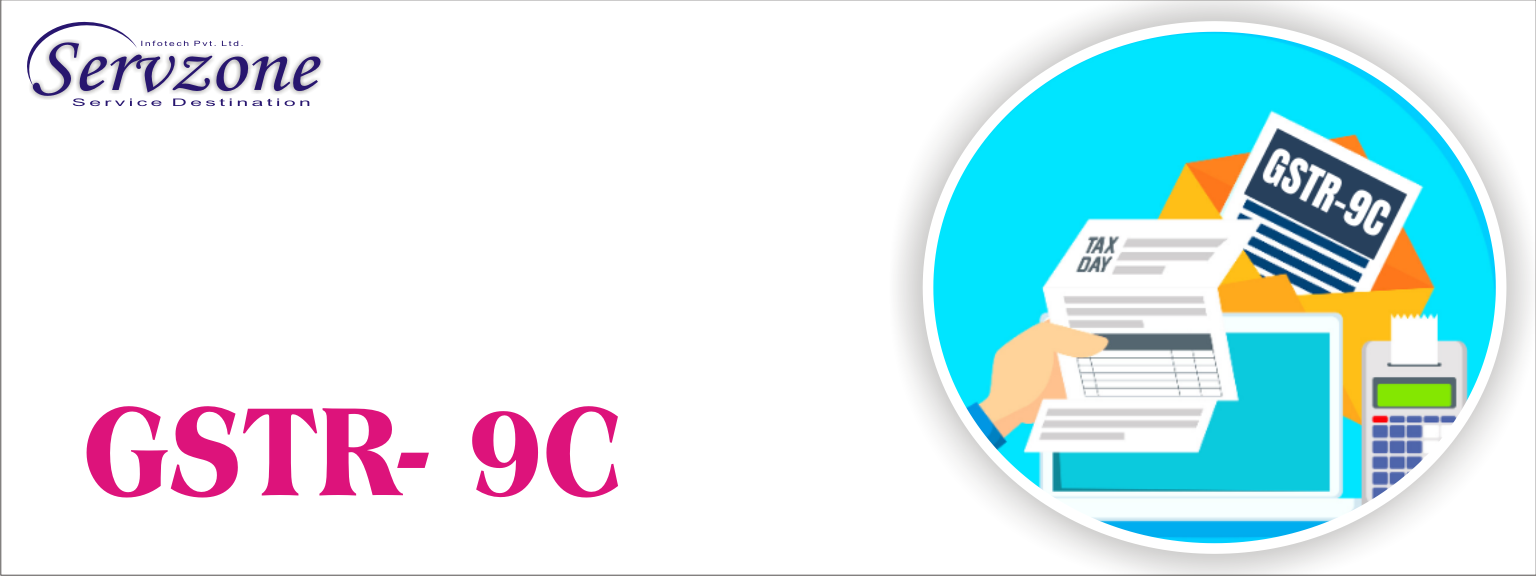Get Started With
servzone
GSTR-9C
GSTR-9C is the reconciliation statement to be filed by all taxpayers registered under GST whose turnover exceeds Rs.2 crore in a financial year. The registered person has to get their books of accounts audited by a Chartered/Cost Accountant. The statement of reconciliation is between these audited financial statements of the taxpayer and the annual return GSTR-9 that has been filed.
GSTR-9C is to be filed for every GSTIN, hence, one PAN can have multiple GSTR-9C forms being filed.
As per the CBIC notification 16/2020, GSTR-9C is waived off for the taxpayers with an aggregate turnover of less than Rs 5 crore for the financial year 2018-19.
GSTR 9C : Reconciliation Statement & Certification- Filing
Every registered person whose aggregate turnover during a financial year exceeds 2 crore rupees shall get his accounts audited as specified under sub-section (5) of section 35 of the CGST Act, and shall furnish a copy of the audited annual accounts and a reconciliation statement, duly certified, in FORM GSTR-9C.
What is GSTR-9C?
Every registered person whose turnover during a financial year exceeds the prescribed limit of rupees 2 crores shall get his accounts audited by a chartered accountant or a cost accountant.
The limit is enhanced to Rs 5 crore for the GSTR-9C of FY 2018-19 as per the CBIC notification dated 23rd March 2020.
GSTR-9C is a statement of reconciliation between:
- the Annual Returns in GSTR-9 filed for a FY, and
- the figures as per the audited annual Financial Statements of the taxpayer.
It can be considered to be similar to that of a tax audit report furnished under the Income-tax act. It will consist of gross and taxable turnover as per the Books reconciled with the respective figures as per the consolidation of all the GST returns for an FY. Hence, any differences arising from this reconciliation exercise will be reported here along with the reasons for the same.
The certified statement shall be issued for every GSTIN. Hence, for a PAN there can be several GSTR-9C forms to be filed.
Who must prepare & submit GSTR-9C?
GSTR-9C must be prepared and certified by a Chartered Accountant or Cost Accountant. It must be filed on the GST portal or through a facilitation centre by the taxpayer, along with other documents such as the copy of the Audited Accounts and Annual Return in form GSTR-9.
This statement is applicable to all those taxpayers who must get their Annual Accounts audited under the GST laws. Audit under GST applies to those registered persons whose Annual aggregate turnover exceeds rupees 2 crores in that FY.
The limit is enhanced to Rs 5 crore for the GSTR-9C of FY 2018-19 as per the CBIC notification dated 23rd March 2020.
What is the due date for GSTR-9C?
The due date for submitting the Annual returns in GSTR-9 is the same deadline for submission of GSTR-9C. Hence, the GSTR-9C must be filed on or before 31st December of the year subsequent to the relevant FY under audit.
The due date can be extended by the Government if deemed necessary.
Due Date Extensions –Update GSTR-9C
- The due date to file GSTR-9 & GSTR-9C for the FY 2018-19 now stands extended up to 30th September 2020.
- The due date for filing GSTR-9 (Annual Return) and GSTR-9C (Reconciliation Statement) for FY 2018-19 is extended to 30th June 2020.
For businesses with an annual turnover of less than Rs 5 crore, filing of GSTR-9C for FY 2018-19 is waived off.
- For businesses with less than Rs 2 crore aggregate turnover in FY 2017-18 and FY 2018-19, no late fee will be charged for the delayed filing of GSTR-9.
*Subject to CBIC notification
- The due date for Form GSTR-9 and GSTR-9C has been again pushed to 5th and 7th of February 2020 by CBIC notification as follows:
- Chandigarh, Delhi, Gujarat, Haryana, Jammu and Kashmir, Ladakh, Punjab, Rajasthan, Tamil Nadu, Uttar Pradesh, Uttarakhand
- Andaman and Nicobar Islands, Andhra Pradesh, Arunachal Pradesh, Assam, Bihar, Chhattisgarh, Dadra and Nagar Haveli and Daman and Diu, Goa, Himachal Pradesh, Jharkhand, Karnataka, Kerala, Lakshadweep, Madhya Pradesh, Maharashtra, Manipur, Meghalaya, Mizoram, Nagaland, Odisha, Puducherry, Sikkim, Telangana, Tripura, West Bengal and Other Territory
- The due date for Form GSTR-9 and GSTR-9C has been extended to 31st January 2020 for FY 2017-18.
- 1. The due date for GSTR-9 and GSTR-9C has been extended to 31st December 2019 and 31st March 2020 for FY 2017-18 and FY 2018-19 respectively.
2. Further CBIC issued Notification No. 56/ 2019 for simplification of GSTR-9/ 9C for FY 2017-18 and FY 2018-19 by making various fields optional.
As per the decision taken at the 37th GST Council Meeting-
What’s the importance of GSTR-9C?
A Chartered Accountant or Cost Accountant must prepare this GST Reconciliation statement. Any differences between the details reported in all the GST returns and the Audited Accounts must be reported by the CA therein with the reasons for the differences. This statement acts as a base for the GST authorities to verify the correctness of the GST returns filed by the taxpayers. This is because the CA has to certify any additional liability arising out of the reconciliation exercise and GST audit in GSTR-9C.
What are the contents of form GSTR-9C?
The GSTR-9C consists of two main parts:
Part-A: Reconciliation Statement
Part-B: Certification
Part-A: Reconciliation Statement
The figures in the audited financial statements are at PAN level. Hence, the turnover, Tax paid and ITC earned on a particular GSTIN( or State/UT) must be pulled out from the audited accounts of the organisation as a whole.
As per Notification No: 56/2019 issued on 14th November 2019
For FY 2017-18 & 2018-19
1. Details of turnover adjustments to be made in tables 5B to 5N have been made optional, and adjustments, if any, which are required to be reported can be reported in Table 5O by the taxpayer.
2. A Taxpayer has the option to not fill details of ITC reconciliation in tables 12B, 12C and 14.
The Reconciliation Statement is divided into five parts as follows:
Part-I: Basic details: Consists of FY, GSTIN, Legal Name and Trade Name. The taxpayer must also mention if he is subject to audit under any other law.
Part-II: Reconciliation of turnover declared in the Audited Annual Financial Statement with turnover declared in Annual Return (GSTR-9):
This involves reporting the gross and taxable turnover declared in the Annual return with the Audited Financial Statements. One must note that most often, the Audited Financial statements are at a PAN level. This might require the break up of the audited financial statements at GSTIN level for reporting in GSTR-9C.
Part-III: Reconciliation of tax paid:
This section requires GST rate-wise reporting of the tax liability that arose as per the accounts and paid as reported in the GSTR-9 respectively with the differences thereof. Further, it requires the taxpayers to state the additional liability due to unreconciled differences noticed upon reconciliation.
Part-IV: Reconciliation of Input Tax Credit (ITC):
This part consists the reconciliation of input tax credit availed and utilised by taxpayers as reported in GSTR-9 and as reported in the Audited Financial Statement. Further, it needs a reporting of Expenses booked as per the Audited Accounts, with a breakup of eligible and ineligible ITC and reconciliation of the eligible ITC with that amount claimed as per GSTR-9. This declaration will be after considering the reversals of ITC claimed, if any.
Part-V: Auditor’s recommendation on additional Liability due to non-reconciliation:
Here, the Auditor must report any tax liability identified through the reconciliation exercise and GST audit, pending for payment by the taxpayer. This can be non-reconciliation of turnover or ITC on account of :
- Amount paid for supplies not included in the Annual Returns(GSTR-9)
- Erroneous Refund to be paid back
- Other Outstanding demands to be settled
Lastly, the instructions to the format of GSTR-9C specifies that an option will be given to taxpayers to settle taxes as recommended by the auditor at the end of the reconciliation statement.
Part-B: Certification
As per Notification No: 56/2019 issued on 14th November 2019
For FY 2017-18 & 2018-19
1. The declaration part includes minor changes, including the declaration by the auditor, which now reads “true and fair†instead of “true and correctâ€, before his/her signature and stamp/seal.
The GSTR-9C can be certified by the same CA who conducted the GST audit or it can be also certified by any other CA who did not conduct the GST Audit for that particular GSTIN.
The difference between the both is that in case the CA certifying the GSTR-9C did not conduct the GST audit, he must have based opinion on the Books of Accounts audited by another CA in the reconciliation statement. The format of Part-B for certification report will vary depending on who the certifier is.
Due Dates of Filing GST Returns
These returns are as per the CGST Act*
|
Return Form |
Description |
Frequency |
Due Date |
|
GSTR-9C |
Certified reconciliation statement |
Annually |
31st December of next financial year. |


GST Registration

PVT. LTD. Company

Loan

Insurance


